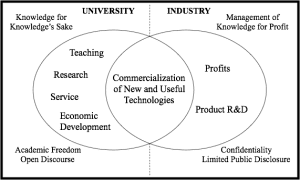The intersection of universities and industry: tech transfer
By Kristopher A. Nelson
in
May 2011
600 words / 3 min.
Tweet
Share
According to Dr. Domonic Montisano of the UCSD’s technology transfer office, their goal is to get university research out to the public through the avenue of commercialization.

Please note that this post is from 2011. Evaluate with care and in light of later events.
Technology transfer offices at universities are responsible for implementing the Bayh-Dole Act of 1980 by licensing inventions of university researchers to industry. The goal? According to Dr. Domonic Montisano of the University of California, San Diego’s technology transfer office, the point is to get university research out to the public through the avenue of commercialization. The point is not to make a fortune, but rather to foster public access to innovations through the transfer of technology to industry. UCSD, Dr. Montisano stressed, never wants technology to sit on the shelf.
There are, of course, numerous challenges for tech transfer offices. Within the university, most scientists are “in it for the science” and not for the money, according to Dr. Montisano. University researchers have the tendency to publish first, forcing his office to chase after them to try to prevent the loss of patent rights (publishing first loses most international rights immediately, though U.S. law allows for a year’s grace). Outside the university, industry values focus on profit first–even if many researchers have been taught to value the science by universities first.

Industry prefers to restrict use of its technologies to those explicitly licensed—and such licensees generally must pay for the privilege of their use. Methods and materials are kept close, as trade secrets, unless licensed out for approved use. Competitors must be kept from access to preserve corporate profits. Universities, on the other hand, have generally taken a much broader approach to technology use and sharing. Researchers in universities must “publish or perish,” and getting describing methods and approaches garners a researcher the most benefit when readership is broad. One-upping academic competitors is still a key goal, but the method is through demonstration and publishing successes, not through profit-making and market dominance.
The Bayh-Dole Act attempted to bridge the divide, and technology transfer offices are the means of its implementation. Prior to Bayh-Dole, “legislators were concerned that for a variety of reasons, the government”–formerly the federal government owned the research it funded–“had proved ineffective as a shepherd of the inventions created with federal research dollars” (see Open Source, Open Access, and Open Transfer: Market Approaches to Research Bottlenecks). By many measures, the results have been phenomenal: at the end of fiscal year 2009, UCSD alone had more than 400 licenses active around the world, with a steady increase since 2000. Also in 2009, UCSD’s technology transfer office distributed more than fifteen million dollars to inventors ($9 million), joint titleholders ($432 thousand) research labs and departments ($2.5 million), and the UC general fund ($2.5 million).
All the money suggests some obvious problems created by the “intrusion” of a neoliberal, market-focused approach into the “ivory tower” university environment (assuming such pure extremes ever existed). For a cash-strapped state government like California’s, why not emphasize this market-connected activity and turn universities into self-supporting institutions? Such an approach risks compromising the university focus of basic research and–perhaps even more importantly–ignores the less commodifiable teaching and research done at such institutions, especially in the humanities. Even within the sciences, forcing research to fit into license agreements and patent arrangements may impede the flow of data, slow down innovation by restricting information sharing, and, ultimately, force university researchers away from basic sciences that form the core of future applications.
Related articles
- Technology Transfer and the Third Way (kfwhite.wordpress.com)
- Columbia University’s Tech Transfer Guru, Orin Herskowitz, on Turning IT, Biotech, and Cleantech Ideas Into Businesses (xconomy.com)
